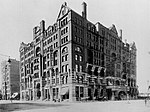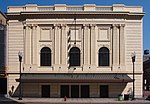Plymouth Building

The Plymouth Building is a 12-story building in Minneapolis. Built in 1910–1911, it was touted as the world's largest all reinforced concrete office building at the time it was constructed.In 1936 the building's exterior was renovated, removing much of the ornamentation and beaux arts styling in favor of a cleaner and more modern appearance. This style of architecture (somewhat typical of government buildings in the 1930s) is sometimes called "starved classicism."In 2014 the building was added to the National Register of Historic Places on the basis of its unique construction methods. Later that year plans were released to convert the building from office space to a boutique hotel.On August 25, 2016, the Plymouth Building re-opened as the Embassy Suites by Hilton Minneapolis Downtown. It has 290 guest suites, 9,000 square feet of meeting space, as well as a connection to the Lyon's Pub next door.
Excerpt from the Wikipedia article Plymouth Building (License: CC BY-SA 3.0, Authors, Images).Plymouth Building
Minneapolis Skyway, Minneapolis
Geographical coordinates (GPS) Address External links Nearby Places Show on map
Geographical coordinates (GPS)
| Latitude | Longitude |
|---|---|
| N 44.978888888889 ° | E -93.273055555556 ° |
Address
Plymouth Building
Minneapolis Skyway
55401 Minneapolis
Minnesota, United States
Open on Google Maps










